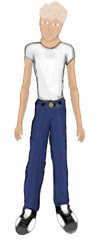Characters:
The following characters appear during gameplay.
Hal
A bitter, cynical man in his late twenties, Hal is perhaps the last person one would expect to become a hero. But fate had other plans…

May
May introduced Hal to his “destiny”, and provides him with invaluable information to help him fulfill it. While it certainly wouldn’t be off-base to question her motives, or even sanity it’s never really a good idea to bite the hand that feeds you.
Mr. Mynar
Mynar is the wealthiest man in Willowbrook, and he’s not afraid to flaunt it. Hey if you owned three-quarters of your hometown, wouldn’t you?
Dr. Smith
Dr. Smith is a wheelchair-bound, maniacal genius with a conspicuous German accent. He runs a lab near the Power Plant, and is rumored to be experimenting with extra-dimensional particles…
Townspeople
All across Willowbrook you will find a vast assortment of people, looking simply to get on with their lives. While some will be wiling to help, and others seem to want the exact opposite, you can’t get by without them.
Vehicles
When you get tired of running, you have several alternatives.
Descartes
Your basic sedan, bland and uninspiring, it was built for the sole purpose of getting you from point A to point B, and certainly does a good job of it. But where’s the fun in that?

Descartes Intellego
The Descartes brand’s renowned pony car, celebrated for its youthful appeal and high level of modability.
Chirac Corsair
It’s a sports car… Drive it like you stole it.

Descartes S
The game’s “secret” vehicle, its un-lockable content, if you will.

Items
Crystals: These are the central focus of the game. There are seven of them to be collected, and you must complete a series of puzzles and quests to retrieve them.
Guitar: The guitar is a musical instrument, play often and the experience you’ll gain will be worth your while.
Cell Phone: Use this to communicate with the various people you meet.
Baseball Bat: A useful multipurpose tool…
Lock Pick: Use this to get into hidden areas.
Money: This allows you to buy products, vehicles, etc.
Food/Drink: Restores health, stamina
Plot Overview:
Willowbrook will be a third-person, side-scrolling RPG that will incorporate 2D animated cutscenes. In this game, the player takes on the role of Hal, an unlucky bachelor who is teleported to another dimension after botching an Internet date with a voodoo priestess. He becomes trapped in a realm, known only as Willowbrook, a small town on the edge of existence, whose residents are continually tormented by a nocturnal race of humanoids, referred to as the Xebufu. In order to escape, he must unite seven mystical stones to power a vessel that will allow him to return to his own dimension. Each scene in this game is to be composed of a 2d bitmap, with each character, item, and vehicle overlaid in such a way as to create a sense of absurd realism. What follows includes:
➢ Each individual scene in the game,
➢ A quoted description as will appear in the instruction manual
➢ List of characters/props
➢ Actions/Control Scheme
Scene 1: Downtown
“Perhaps the most important area of this game is downtown Willowbrook. This is where Hal will meet the majority of the characters he will interact with and find many of the items that will help him along his “quest”.
Points of Interest:
Korova’s
“The local “milk bar”, this is where many young people come to unwind at the end of a long day. It’s probably best to show up after dark …”
Alonzo’s Pre-owned Auto Emporium
“The latest from a long line of used car salesmen, Alonzo has without a doubt perfected the art of preying on the wallets of the poor and naïve. Still, his penchant for finding rare and interesting vehicles is unmatched. The complementary beverages don’t hurt either…”
Ed’s Threads
“Ed is the local tailor, some say he is the best around, whether that’s because he’s the only tailor in Willowbrook is uncertain…”
Testament
“A local club, it’s where Willowbrook’s best musicians come to strut their stuff.”
Underground:
“The sewers of Willowbrook, it’s amazing what you might find down here.”
Scene 2: Outskirts
“This is the vast expanse that lies beyond the center of town. It would be unwise to navigate by foot…”
Points of Interest:
The Suburbs:
“This is where the working man takes refuge after a long day at the office, disappearing into the uniformity of middle class existence.”
Semetary Hill:
“When your time comes in Willowbrook, it’s likely you’ll end up here…”
Rt. 616:
“This vast, straight throughway is a favorite haunting ground for street racers of all kinds. Head out here to test your mettle.”
The Garbage Plant:
“This is where the essentials of civilization end up when they have outlived their useful purpose, to generate electricity”










